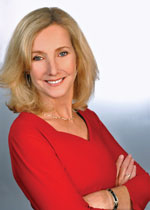News
Coca-Colas Julie Seitz Offers Prediction Of Future Workplace Needs For Vending And Refreshment Services
June 23, 2015
TAGS: vending machine, office coffee service, Coca-Cola vending, Coke, micro market, refreshment service, workplace refreshments, vending, vending operators, Julie Seitz, National Automatic Merchandising Association, NAMA OneShow, Workplace 2020 initiative, Coca-Cola Co., break rooms |
 |
Julie Seitz |
Coke's Workplace 2020 Initiative began as a program to assure that the company will continue to attract the best available talent. Among other things, this has involved major renovations to Coke's Atlanta headquarters. Seitz, the 18-year company veteran who is coordinating the program, said that workplace design is evolving swiftly in response to the fast-changing environment.
In the immediate postwar years, she recalled, the typical American office was a "bullpen," with a receptionist's desk near the entrance. At that time, the water cooler was the focal point for conversations among employees. It then shifted to the vending area. In the 1960s, office designers responded to the perceived need for greater privacy by installing cubicles, usually styled in restful beige or gray. "The sense of privacy, though, is illusory," Seitz pointed out, "because those walls don't block sound." What they do block is ambient light, and that characteristic became more pronounced as the cubicle walls were made higher.
The trend today is toward the "work café," the keynote speaker reported. "The goal is an inviting environment, one that you'll want to come to work in." In concept, it is open, well lit and furnished in a manner that encourages quick conversations during chance encounters. This trend presents a challenge to operators, Seitz warned; but also offers great opportunity.
"The 'work café' can be imagined as a combination of an airport lounge and a Starbucks, offering connectivity plus access to food and beverages," the Coke veteran explained. "These environments are taking shape right now; what can you do to support them?"
The same trend is "evolving" conventional workplace cafeterias and lunchrooms out of existence, Seitz continued. But it is expanding to outdoor spaces, and its foodservice dimension increasingly is inspired by contemporary commercial restaurants: "places where you can eat, plug in and work," she summarized.
Seitz recalled that everyone has been hearing about the differing needs of the Silent Generation, the Boomers, Generations X, Y and Z, and now Millennials in the workplace. "And you may respond, 'So what? We've had 18- to 65-year-old workers for a really long time."
The difference is that the recent arrivals to the workplace have dramatically different communication styles, traditions, experiences and expectations; and, by 2022, 59% of workers will be Millennials. "In 1985, we went to the office to do our jobs; now, we can work anywhere we want to. The employer's task is to convince employees to come to work; 70% of U.S. workers are not engaged in -- or disengaged from -- their jobs. And highly engaged workers are three times as effective. They want flexibility in where they work."
Approached imaginatively, this holds great potential for vending and OCS operators. Something to keep in mind when thinking about it is that it represents a turn away from the "telecommuting" future envisioned at the turn of the millennium. "In 2013, Yahoo! took away telecommuting, recognizing that people together are more effective," Seitz pointed out. "And Google thinks so, too; it even runs free buses for its staff. Creative people need face-to-face dialogue."
A good starting-point for operators positioning themselves to take advantage of these developments is to recognize that more and more employers are looking for solutions. "Offer more robust food and beverage options," the Coca-Cola executive recommended. "And meet contemporary consumer attitudes by communicating with patrons through smartphones."
A more diverse workforce demands a wider range of options, and expects convenience. "Look at micromarkets," Seitz instanced. "Make it easier to buy from you. Take part in rethinking the breakroom."
Vending and coffee service always have emphasized their roles in enhancing worker productivity and building morale. That role is becoming critical, and the future will belong to those who fill it best.


